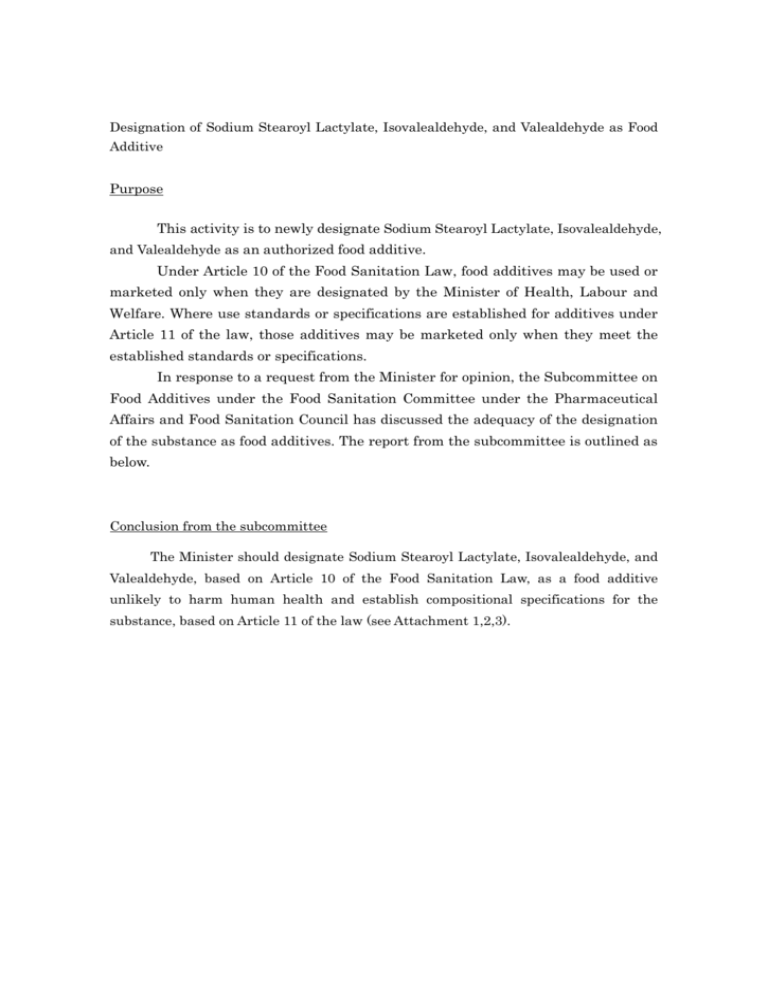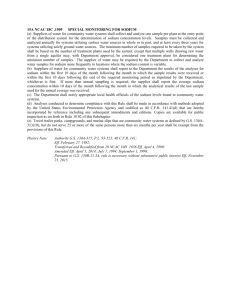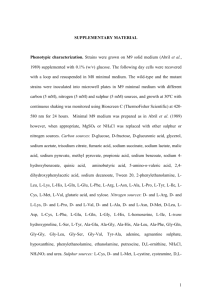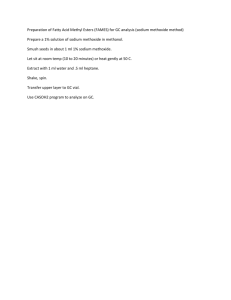Standard for use
advertisement

Designation of Sodium Stearoyl Lactylate, Isovalealdehyde, and Valealdehyde as Food
Additive
Purpose
This activity is to newly designate Sodium Stearoyl Lactylate, Isovalealdehyde,
and Valealdehyde as an authorized food additive.
Under Article 10 of the Food Sanitation Law, food additives may be used or
marketed only when they are designated by the Minister of Health, Labour and
Welfare. Where use standards or specifications are established for additives under
Article 11 of the law, those additives may be marketed only when they meet the
established standards or specifications.
In response to a request from the Minister for opinion, the Subcommittee on
Food Additives under the Food Sanitation Committee under the Pharmaceutical
Affairs and Food Sanitation Council has discussed the adequacy of the designation
of the substance as food additives. The report from the subcommittee is outlined as
below.
Conclusion from the subcommittee
The Minister should designate Sodium Stearoyl Lactylate, Isovalealdehyde, and
Valealdehyde, based on Article 10 of the Food Sanitation Law, as a food additive
unlikely to harm human health and establish compositional specifications for the
substance, based on Article 11 of the law (see Attachment 1,2,3).
Attachment 1
Sodium Stearoyl-2-lactylate
Sodium Stearoyl Lactylate
Standard for use
See the Appendix.
Compositional specifications
Substance name
Sodium Stearoyl-2-lactylate
Structural formula
*The lactic acid may contain its dextrorotatory form and racemic form.
Molecular formula and molecular weight of major components
C21H39O4Na (R-CO: stearoyl group CH3(CH2)16, n=1) Mol. Wt. 378.53
C24H43O4Na (R-CO: stearoyl group CH3(CH2)16, n=2) Mol. Wt. 450.59
C19H35O4Na (R-CO: palmitoyl group CH3(CH2)14, n=1) Mol. Wt. 350.47
Chemical name, CAS number
Monosodium 2-(octadecanoyloxy)propanoate [25383-99-7]
Monosodium 2-{[2-(octadecanoyloxy)propanpyl]oxy}propanoate [25383-99-7]
Monosodium 2-(hexadecanoyloxy)propanoate [617-57-2]
Definition Sodium Stearoyl-2-lactylate is a mixture of sodium salts of stearoyl lactylic
acids as major components and minor proportions of related acids and other salts of
these acids.
Description It occurs as a white to slightly yellowish powder or brittle solid with a
characteristic odor.
Identification
(1) Add 10 ml of diluted hydrochloric acid (1 in 4) to 2 g of Sodium
Stearoyl-2-lactylate, heat in a water bath for 5 minutes, and filter. The filtrate imparts
a yellow color to the flame. Next, neutralize the filtrate and add potassium hydrogen
pyroantimonate TS. A white crystalline precipitate is formed.
(2) To the residue obtained by filtration in test (1), add 30 ml of sodium hydroxide
(1 in 25), and heat while stirring for 30 minutes in a water bath at a temperature of not
less than 95ºC. After cooling, add 20 ml of diluted hydrochloric acid (1 in 4). Extract
twice from the mixture with two 30 ml portions of diethyl ether, and combine the diethyl
ether layers, and wash with 20 ml of water. Add anhydrous sodium sulfate to dehydrate,
and filter. Heat the filtrate on a water bath to completely evaporate the diethyl ether.
The melting point of the residue is 54–69ºC.
(3) Sodium Stearoyl-2-lactylate responds to the test for Lactate in the Qualitative
Tests.
Purity
(1) Acid value 60–130.
Weigh accurately about 1 g of Sodium Stearoyl-2-lactylate, add 25 ml of neutralized
ethanol, and dissolve while warming. After cooling, add 5 drops of phenolphthalein TS,
and immediately titrate with 0.1 mol/L sodium hydroxide to the first fain pink that
persists for 30 seconds. Calculate the acid value by the formula
Acid value
volume ( ml) of 0.1 mol / L sodium hydroxide consumed 5.611
.
Weight ( g ) of the sample
(2) Ester value 90–190 (Fats and Related Substances Tests).
To determine the ester value, use the acid value calculated in (1). To determine the
saponifacation value, proceed as directed in Saponification Value under the Fats and
Related Substances Tests, using 1 g of Sodium Stearoyl-2-lactylate, accurately weighed.
When adding ethanolic potassium hydroxide TS, be careful not to let the deposits
produced adhere to the wall of the flask. Titration should be performed while hot.
(3) Total lactic acid 15–40% as lactic acid (C3H6O3).
Proceed as directed in Purity (3) for Calcium Stearoyl Lactylate.
To prepare a
calibration curve, use 1, 2, 5, and 10 ml of Lithium Lactate Standard Solution,
respectively.
(4) Sodium 2.5–5.0%.
Test Solution Place about 0.25 g of Sodium Stearoyl-2-lactylate, accurately weighed,
into a beaker, add 10 ml of ethanol, and dissolve while warming. Transfer this solution
into a 25-ml volumetric flask, wash the beaker twice with two 5 ml portions of ethanol,
and add the washings to the flask. Make up to volume with ethanol, and mix well.
Transfer exactly 1 ml of the resulting solution into a 100-ml volumetric flask containing
10 ml of lanthanum oxide TS, make up to volume with water, and filter through a 5C
filter paper.
Standard Solutions Dissolve 1.271 g of sodium chloride, dried at 130ºC for 2 hours
and exactly weighed, in water to make exactly 500 ml. To exactly 10 ml of this solution,
add water to make a standards stock solution of exactly 100 ml (0.1 mg/ml Na). Place
exactly 1, 2, 4, and 6 ml of the stock standard solution into separate 100-ml volumetric
flasks, add 10 ml of lanthanum oxide TS to each, and dilute to volume with water. These
solutions contain 2, 4, and 6 μg of sodium (Na=22.99) per ml, respectively. Prepare
standard solutions fresh. Perform the test by the Flame Method in Atomic Absorption
Spectrophotometry, using the operating conditions given below. Prepare a calibration
curve using the standard solutions to determine the sodium concentration, and
calculate the sodium content by the formula
Concentration (g / ml) of sodium
Sodium content(%)
.
Weight ( g ) of the sample 4
Operating Conditions
Light source: Sodium hollow cathode lamp
Wavelength: 589.0 nm
Supporting gas: Air
Combustible gas: Acetylene
(5) Lead Not more than 2.0 μg/g as Pb (5.0 g, Method 1).
(6) Arsenic Not more than 4.0 μg/g as As2O3.
<Reagents>
Lanthanum Oxide (III) La2O3 White crystals.
Loss on Ignition Not more than 0.5% (1 g, 1000ºC, 1 hour).
Lanthanum Oxide TS Place 5.86 g of Lanthanum Oxide (III) into a 100-ml volumetric
flask, add 2 to 3 ml of water to moisten, and slowly add 25 ml of hydrochloric acid.
Shake to dissolve completely, and make up to volume with water.
Appendix
Standards for use
Target Food
Maximum Limit
Limitation for Use
(g/kg)
Bread.
4.0
Butter cakes.
5.5
Confections (baked or fried wheat flour
products only, excluding sponge cakes and
butter cakes).
4.0
Moist cakes (rice flour products only).
6.0
Macaroni and other such products.
4.0 *
Mixed powder for manufacturing:
Bread.
5.5
Confections (fried wheat flour products only).
5.5
Confections (baked wheat flour products only,
excluding sponge cakes and butter cakes).
5.0
*per kg
noodles.
of
dry
Moist cakes.
10
Sponge cakes, butter cakes and steamed
breads.
8.0
Steamed MANJYU (bun made by steaming
wheat flour dough).
2.5
Noodles (raw noodles and instant noodles,
excluding other dry noodles).
4.5 **
Sponge cakes.
Steamed bread (bread made by steaming wheat
flour dough).
5.5
5.5
Steamed MANJYU
2.0
**per kg of boiled
noodles.
Attachment 2
Isovaleraldehyde
3-Methylbutyraldehyde
3-Methylbutanal
Standard for use
It must not be used for purposes other than flavoring.
Compositional specifications
Substance name
Isovaleraldehyde
Structural formula
O
Molecular formula C5H10O
Mol. Weight 86.13
Chemical name, CAS number
3-Methylbutanal [590-86-3]
Content Isovaleraldehyde contains not less than 95.0% of butyraldehyde (C5H10O).
Description
Isovaleraldehyde occurs as a colorless to light yellow liquid, having a
characteristic odor.
Identification
Determine the infrared absorption spectrum of Isovaleraldehyde, as
directed in the Liquid Film Method under Infrared Spectrophotometry, and compare it
with the Reference Spectrum. Both spectra exhibit absorptions having about the same
intensity at the same wave numbers.
Purity
(1) Refractive index n 20
D : 1.387–1.408.
(2) Specific gravity d 25
25 : 0.795–0.815
(3) Acid value Not more than 10.0 (Flavoring Substance Tests).
Assay
Proceed as directed in the Peak Area Percentage Method in the Gas
Chromatographic Assay under the Flavor Substance Tests. Use operating conditions (2).
Reference Spectrum
Attachment 3
Valeraldehyde
Pentanal
Standard for use
It must not be used for purposes other than flavoring.
Compositional specifications
Substance name
Valeraldehyde
Structural formula
H3C
CHO
Molecular formula C5H10O
Mol. Weight 86.13
Pentanal [110-62-3]
Content Valeraldehyde contains not less than 95.0% of butyraldehyde (C5H10O).
Description Valeraldehyde occurs as a colorless to light yellow liquid, having a
characteristic odor.
Identification Determine the infrared absorption spectrum of Valeraldehyde, as
directed in the Liquid Film Method under Infrared Spectrophotometry, and compare it
with the Reference Spectrum. Both spectra exhibit absorptions having about the same
intensity at the same wave numbers.
Purity
Chemical name, CAS number
(1) Refractive index n 20
D : 1.390–1.400.
(2) Specific gravity d 25
25 : 0.805–0.820
(3) Acid value Not more than 5.0 (Flavoring Substance Tests).
Assay
Proceed as directed in the Peak Area Percentage Method in the Gas
Chromatographic Assay under the Flavor Substance Tests. Use operating conditions (2).
Reference Spectrum






